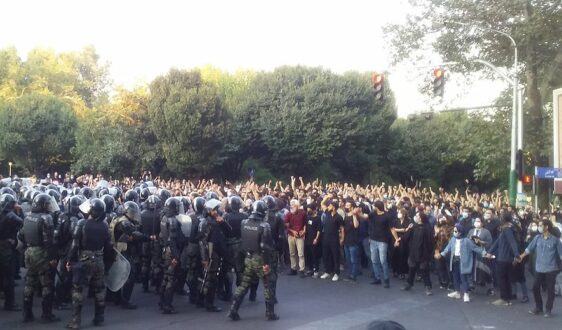Al-Monitor – Iranian protesters are beginning to shift tactics to adapt to a sweeping campaign of arrests and a near-total internet shutdown aimed at stifling their message.
For a firsthand account of anti-government protests that have raged for nearly two weeks, The Takeaway reached out to an Al-Monitor correspondent in Tehran, who says “life is hanging in the balance” amid the outpouring of public anger.
“Everyone is wondering what is happening next,” says the correspondent, whose name we are withholding out of security concerns. “Almost everyone can feel the tense air and the uncertainty … While mornings are normally quiet, tension gradually builds up as the evening draws close, which is when people get together in multiple locations.”
Protests that began over the Sept. 16 death of 22-year-old Mahsa Amini in police custody have morphed into something much bigger, our correspondent says. Compared to the protests of 2009 and 2019, “the key difference now is women’s centrality and inclusiveness.”
The clampdown continues. Rights groups have documented an increasingly brutal crackdown on what the Iranian government labels “riots.” At least 76 people have been killed by direct gunfire from security forces, the Oslo-based Iran Human Rights reported. As of Wednesday, the government’s official toll stood at 41 and included several police and paramilitary forces.
“The police and intelligence apparatus have gone the extra mile to scare the protesters away, and this has caused the size of the protests to dwindle compared to the first few days,” our correspondent says. “But that doesn’t mean they have died down or the anger has been eased — not at all.”
New forms of protest. People are also changing tactics as the crackdown intensifies, reports our correspondent. “People are taking to rooftops and windows at nights shouting slogans that target the very basis of the system.”
Teacher unions have announced strikes, and students are boycotting classes. On Wednesday, there were reports that drivers for Snapp, the widely used Iranian version of Uber, were going on strike.
“The protesters are thirsty for global solidarity,” our correspondent says. “What they want is meaningful support from politicians, something that goes beyond statements … In their view, Obama failed Iranians in the 2009 protests.”
Former president Barack Obama’s initial response to the election protests was muted, rooted in the belief that the United States should not be seen as interfering in Iran’s domestic affairs.
Thirteen years later, President Joe Biden’s administration is less cautious. In addition to backing the protests in his UN General Assembly speech, Biden’s administration has also imposed sanctions on Iran’s morality police and hinted at more to come.
Last week, the US Treasury Department authorized US technology firms to provide additional internet services in Iran, a move aimed at helping the protests circumvent government censorship.
“[The United States] wanted to interfere in our internal affairs,” Iran’s foreign minister, Hossein Amir-Abdollahian, told Al-Monitor in an interview Sunday. Of the clampdown, he said, one must “respond to riots in a powerful, mighty way.”
From our regional contributors
1. Iran strikes Kurdish opponents in Iraq amid protests
As Iranians protest the death of a 22-year-old Kurdish woman in custody of Iran’s morality police, the Islamic Republic is ramping up its bombing campaign in the Kurdish region of neighboring Iraq. At least nine people were killed by Iranian drone and missile attacks Wednesday targeting the headquarters of three separate Iranian Kurdish opposition groups based in Iraqi Kurdistan. “The regime seems unnerved by the solidarity shown by non-Kurdish Iranians and opposition groups with the country’s Kurds because of Amini’s death,” Amberin Zaman reports. Kurds make up roughly a tenth of Iran’s population and have long been denied political and cultural rights.
 Shabtabnews In this dark night, I have lost my way – Arise from a corner, oh you the star of guidance.
Shabtabnews In this dark night, I have lost my way – Arise from a corner, oh you the star of guidance.



